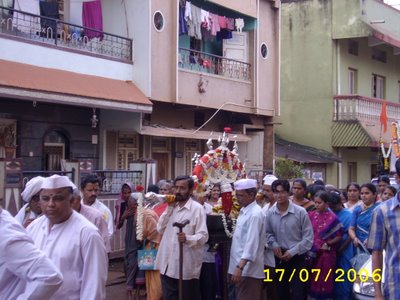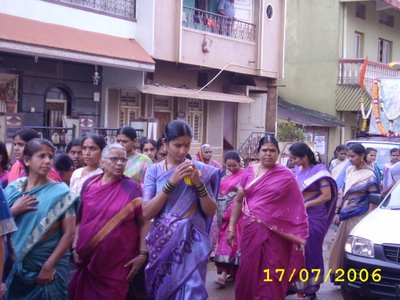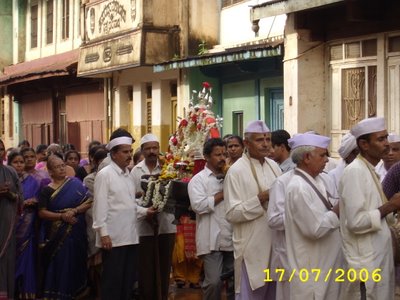Ashadha Dindi

Have you heard Sant Eknath's abhang "Majhe maher pandhari" (my mother's house - tavarumane - is Pandharapur) sung by Pt. Bhimsen Joshi ? Beutifully rendered, this abhnag captures aptly the devotion towards personal God as expressed by the poet seers of Maratta region.

Pandharapur is situated in the southern district of Maharasthra - Sollapur (Sholapur), on the banks of river Bheema, also called locally as Chandrabhaaga. This place witnessed a kind of devotional fervour from 14th to 16th century. Devotees thronged from different walks of life to the temple of Vithoba or Vittala. There was Jnana and Karma - with high devotion.

There was Sant Jnaneshwar of Alandi, a boy prodigy of brahmin caste, son of a monk-turned-householder, who wrote the "Jnaneshwari", a commentary on Bhagavad Geeta in commoners' language of Marathi. The film depicting his life, about his 3 brothers and a sister, muktabai has been one of my favourites. Their contribution - integration of the then prevailing Nath tradition and Vaishnava - Warakari tradition is still a strong force.

While Naamdev was a 'egoistic' scholar devotee of Vithoba who wanted to be recognised as the numero uno devotee, there was Gora, the potter. Yea, Raj kumar's Bhakta Kumbara with its most melodious songs was based on his story. There there was poor Tukaram, who had to always listen to his pining wife. Sakhoobai, was tormented by her mother in law, and story has it that Lord took her form and did all household work, while she went to Pandharpur to visit Lord - all without the knowledge of her mother-in-law. There was Janabai, there was Chokhamela etc. etc. I have seen a beautiful picture in which two-handed Vithoba is standing while all his devotees are sitting on his shoulders, hands, legs etc and singing madly.

This centre of faith was destroyed by moslems completely. But can the faith in lord be destroyed so easily ? Even today, people of all caste are allowed inside the temple, and what more - you are allowed to embrace the Lord's feet. There is a pillar in the temple associated with the memory of our own Purandaradasa. After all Vithala has been the ankita-naama of all our Haridasas.

In the month of Ashadha, people walk to Pandharapur to reach on maha-ekadashi. They take holy bath and visit the Lord. You can see old aged women in the typical maharashtrian attire - kachche saree- jumping and praying to lord. They dance and jump out of joy there.

These trips are called Dindis - and even today people from places like Dharwad walk to Pandharapur. In Dharwad, they come from a community called Marathas - a low caste - mainly in the work of washermen and tailors.

They have weekly singing programme also. They move singing and dancing on the road - stopping at all the temples on the way to pay their respects to corresponding dieties. There is a leader who leads them, and they carry a copy of Jnaneshwari, which is worshipped. Sometimes there is Vithala's statue. At the end of the programme, each man/woman touches the feet of each other devotee - all do it, the leader to the followers, the old man to younger people - symbolising Lord devotees are Lord himself. Dint Shri Ramakrishna often say - "Bhakta, Bhagawan and Bhagavat" are all same ?

I have seen this singing/dancing - naama sakeertane - amongst ISKCON. Even vidyashala has rightly introduced it now, with the new receptionist leading the bhajans. But these dont match the Varakari bhajans. At Vidyashala also, "Aananda cha kanda harila" was a favourite of many students.
My home is on the main street of old Dharwad, and this weekend when i was having my evening tea, i heard the Taals and singing of the Dindi. I quickly ran and took some pics, which i am attaching here. Unfortuntely some pics got deleted. At the end my mom asked me if i offer dakshina to them, and i said i forgot ! My mom laughed and said, "how foolish".

Lastly, the jai-kaara that is given is "Jai Pundaleeka Varade, Panduranga Vittalaaa" - hail to Panduranga Vittala, bestower of boon to Pundaleeka

0 Comments:
Post a Comment
<< Home